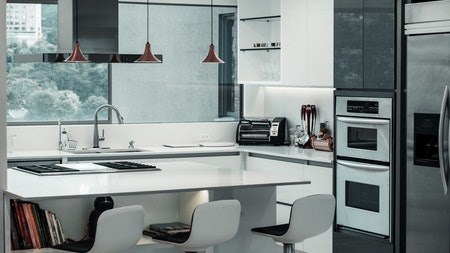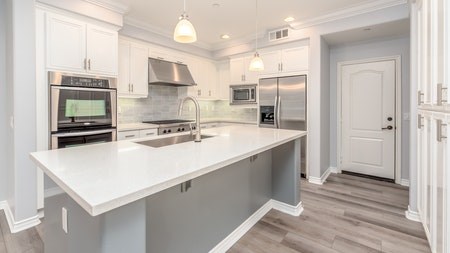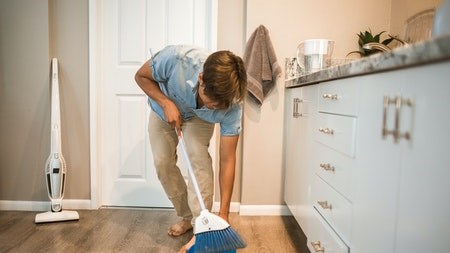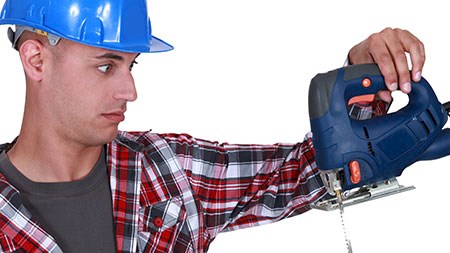The most important thing to keep in mind when designing a kitchen for people with disabilities or the elderly is the specific needs of the users.
Are they left- or right-handed? Are there mobility issues that will require more room or lower working heights? Will they be working from a wheelchair or a walking frame or using any other assistive devices?
In making a kitchen accessible, you must consider all these factors and put everything within reach. Creating several work areas can make it easier to access them from a single position. Activity centres could include a baking area, a salad counter, a washing-up space and a passage between the garage and pantry for transferring groceries.
Work surface heights
Providing the correct working height and reach adjustments is even more important when designing a kitchen for an elderly or disabled user than for non-disabled people. Countertops, storage, sinks and appliances just a few centimetres higher or lower can mean the difference between just right and completely non-useable.
The ideal height for a countertop will depend on the position of your elbows while in a typical working position. For example, if you are seated in your wheelchair or using a walker with a seat. With palms down on the countertop, your elbows should be resting, with your forearms, at 45 degrees above the work surface.
- The accessible counter workspace is 75 cm wide.
- The countertop must not be obstructed by base cabinets to allow for knee and toe clearance.
- Pull-out shelves sliding out of the countertop is another way to create an easily accessible food preparation space.
Stove tops should be slightly lower for working surfaces so that you can look down into pots and pans without strain. A stand-alone hob – rather than a stove with an oven – will enable you to customise the height to your specific needs. Ensure the extractor hood has a high enough clearance above the hob, so you don’t accidentally bump your head.
The top of your oven should be at shoulder height when in your wheelchair so that you can easily see what is inside and don’t have to reach down to remove hot items.
Sinks need open space below to allow wheelchair or walker users to access the sink.
Knee clearance for a sink needs to be at least 70 cm high and 20 cm deep at the knees.
The drain should be at the back of the sink so the piping won’t obstruct a person in a wheelchair.
Hot water pipes should be insulated or enclosed to prevent accidental burns.
Set geyser temperature to a maximum heat which is low enough to prevent burning.
Mixer taps are easier to operate for people with disabilities, and installing them to the side of the sink may make it more accessible for some users. Other options include touch control taps that allow you to turn them on and off with one touch.
Sliding drawers on either side of the sink will provide easy storage of cleaning products.
Storage
When designing kitchen cabinets and other storage facilities, you need to avoid having to reach above your head for anything heavier than a box of cereal. Ergonomically-correct reaching height is just above eye level. To calculate the correct height for shelves, note the level of your elbows when you reach above your head.
- Pull-out shelves and lazy Susans in cabinets will make items easier to find and reach.
- Electric-powered adjustable cabinets will allow you to lower and raise cabinet heights at the touch of a button, making the storage space accessible to all users.
- Looped cabinet pulls – in place of knobs – can be operated with a closed fist. This means you don’t have to twist, grasp or use pinching motions.
- Other useful cabinet hardware includes full extension drawers, touch-release drawers and doors, and swing-up hinges that allow cabinet doors to hinge at the top and stay open.
- Place often-used items within reach on countertops, for instance, spice racks and cutting boards.
- Use drawers below countertops for heavy items such as crockery, pots and pans and glassware to avoid the strain of lifting while reaching.
- Sliding doors for kitchen cabinets can also reduce awkward movement and add a new aesthetic to the space.
Lighting
Glare-free lighting and good task lighting will increase visibility and create a safe cooking environment.
Adding dedicated illumination for each work surface will make all the difference when it comes to creating an efficient and comfortable kitchen. The key is to position task lights to cast as little shadow as possible on the preparation surface.
Place the lighting controls so you won’t have to navigate in the dark. If you can access the kitchen from several points, a toggle switch will allow you to turn the kitchen lights on and off when you enter or exit.
Appliances
- A gas or electric hob with staggered burners and controls on the front will eliminate having to reach across hot pots.
- Raising the dishwasher 15 cm off the floor and making it reachable from either side will improve access.
- A side-hinged oven door will allow a seated cook to get closer to the oven contents.
- A bottom-door refrigerator is more accessible than a top-door fridge for wheelchair users.
- Consider which way you want appliance doors to swing open and make sure you can access the appliance without contorting your body.
- Appliances with touchpad operation are more suitable for people with limited finger strength and control.
- Using a base cabinet on wheels is ideal for transporting hot dishes from countertop to table or creating a moveable workspace.
If possible, before committing to a permanent design, you should set up the kitchen space and use it for a few days to see if it meets your needs and how to adjust it. Try out various heights using adjustable tables before installing permanent cabinets and countertops. This will enable you to determine the ideal dimensions that work for each member of the family.
Writer : Sarah-Jane Meyer




